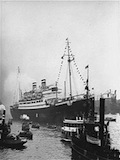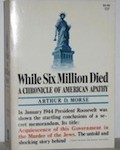In the aftermath of Kristallnacht, large numbers of Jews sought to flee Nazi Germany. A ship called the St. Louis, carrying 930 German Jewish refugees, set sail from Hamburg in May 1939. The passengers held visas to enter Cuba. But Cuban public opinion was turning sharply against immigration, and when the St. Louis docked at Havana, the Cuban government refused to honor the refugees’ entry visas. Attempts by the American Jewish Joint Distribution Committee to persuade Cuban president Laredo Bru to admit the passengers proved unsuccessful.
Some of the passengers’ relatives had reached Cuba earlier, and as the St. Louis waited in the harbor, they boarded small boats that took them closer to the ship, to catch a glimpse of their loved ones and shout messages of encouragement.
When it became clear that Cuba would not admit the passengers, Captain Gustav Schroeder sailed the St. Louis north to the coast of Florida. It hovered there for three days, hoping President Roosevelt would grant them permission to land.
The passengers sent a telegram to the White House, pleading for mercy and emphasizing that “more than 400 [of the refugees] are women and children.” The reply came in the form of a Coast Guard cutter, which was dispatched to the scene to make sure the St. Louis did not come closer to America’s shore. The New York Times dubbed the ship “the saddest ship afloat,” although the newspaper did not advocate granting the refugees entry to the United States.
America’s strict immigration laws severely limited the number of foreigners that could be admitted, and by the spring of 1939, the German quota for 1938-1939 was filled (it was the only year between 1933 and 1945 that the administration permitted it to be completely used). Nevertheless, the president could have issued an executive order to place the refugees in a temporary detention center until it was safe for them to return to Germany. Treasury Secretary Henry Morgenthau, Jr. proposed that they be admitted as tourists to the Virgin Islands, which as a U.S. territory rather than a state was not governed by the immigration limits. In the aftermath of Kristallnacht, the governor and legislative assembly of the Islands had offered to open their doors to Jewish refugees. However, Secretary of State Cordell Hull turned down Morgenthau’s proposal on the grounds that the passengers did not have valid addresses in Germany to which they could return after their tourist visas expired. Ironically, his decision meant that, as far as he knew, the refugees would indeed return to Germany even without valid addresses.
With America’s doors closed, the St. Louis slowly sailed back towards Europe. A Nazi newspaper, Der Weltkampf, gloated: “We are saying openly that we do not want the Jews, while the democracies keep on claiming that they are willing to receive them–then leave them out in the cold.”
Meanwhile, the American Jewish Joint Distribution Committee initiated negotiations with a number of European governments to take in the refugees. Before the ship reached Europe, England, France, Belgium, and the Netherlands each agreed to accept a portion of the St. Louis passengers. Those who were admitted to England survived the war. But less than a year later, the Germans invaded France, Belgium, and the Netherlands. Nearly half of the St. Louis refugees who remained in those countries were eventually murdered in Nazi death camps.
Sources: Medoff, FDR and the Holocaust, pp.8-9; Lipstadt, Beyond Belief, pp.115-120.











